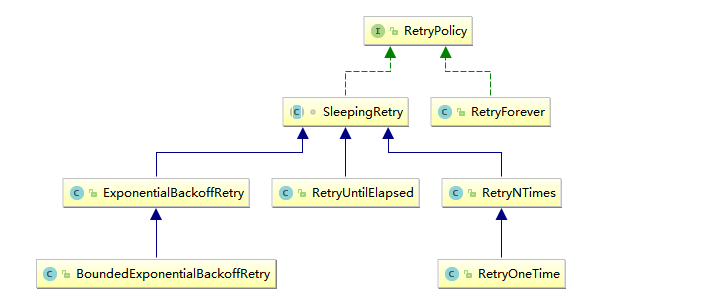Zookeeper Java 客户端 ——Apache Curator
一、基本依赖
Curator 是 Netflix 公司开源的一个 Zookeeper 客户端,目前由 Apache 进行维护。与 Zookeeper 原生客户端相比,Curator 的抽象层次更高,功能也更加丰富,是目前 Zookeeper 使用范围最广的 Java 客户端。本篇文章主要讲解其基本使用,项目采用 Maven 构建,以单元测试的方法进行讲解,相关依赖如下:
1 | <dependencies> |
完整源码见本仓库: https://github.com/heibaiying/BigData-Notes/tree/master/code/Zookeeper/curator
二、客户端相关操作
2.1 创建客户端实例
这里使用 @Before 在单元测试执行前创建客户端实例,并使用 @After 在单元测试后关闭客户端连接。
1 | public class BasicOperation { |
2.2 重试策略
在连接 Zookeeper 时,Curator 提供了多种重试策略以满足各种需求,所有重试策略均继承自 RetryPolicy 接口,如下图:

这些重试策略类主要分为以下两类:
- RetryForever :代表一直重试,直到连接成功;
- SleepingRetry : 基于一定间隔时间的重试。这里以其子类
ExponentialBackoffRetry为例说明,其构造器如下:
1 | /** |
2.3 判断服务状态
1 |
|
三、节点增删改查
3.1 创建节点
1 |
|
创建时可以指定节点类型,这里的节点类型和 Zookeeper 原生的一致,全部类型定义在枚举类 CreateMode 中:
1 | public enum CreateMode { |
2.2 获取节点信息
1 |
|
如上所示,节点信息被封装在 Stat 类中,其主要属性如下:
1 | public class Stat implements Record { |
每个属性的含义如下:
| 状态属性 | 说明 |
|---|---|
| czxid | 数据节点创建时的事务 ID |
| ctime | 数据节点创建时的时间 |
| mzxid | 数据节点最后一次更新时的事务 ID |
| mtime | 数据节点最后一次更新时的时间 |
| pzxid | 数据节点的子节点最后一次被修改时的事务 ID |
| cversion | 子节点的更改次数 |
| version | 节点数据的更改次数 |
| aversion | 节点的 ACL 的更改次数 |
| ephemeralOwner | 如果节点是临时节点,则表示创建该节点的会话的 SessionID;如果节点是持久节点,则该属性值为 0 |
| dataLength | 数据内容的长度 |
| numChildren | 数据节点当前的子节点个数 |
2.3 获取子节点列表
1 |
|
2.4 更新节点
更新时可以传入版本号也可以不传入,如果传入则类似于乐观锁机制,只有在版本号正确的时候才会被更新。
1 |
|
2.5 删除节点
1 |
|
2.6 判断节点是否存在
1 |
|
三、监听事件
3.1 创建一次性监听
和 Zookeeper 原生监听一样,使用 usingWatcher 注册的监听是一次性的,即监听只会触发一次,触发后就销毁。示例如下:
1 |
|
3.2 创建永久监听
Curator 还提供了创建永久监听的 API,其使用方式如下:
1 |
|
3.3 监听子节点
这里以监听 /hadoop 下所有子节点为例,实现方式如下:
1 |
|

